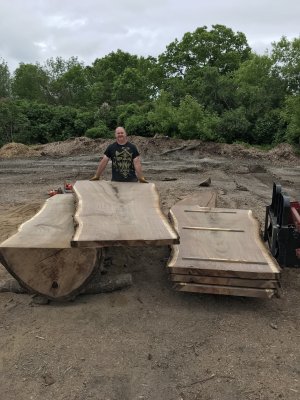TorontoBuilder
Sapientia et Doctrina Stabilitas
My brother's partner is a very picky woman who wanted a custom made dining room table.
But she had so many design criteria and often could not articulate them all or made conflicting statements while doing so... But in the end I was able to come close to what she wanted and better yet we were able to find wood that meets her tastes.
This maple board has enough defects that it will suit the rustic aesthetic she wanted, but does not have too much grain which she did not want. But best of all it does have a lovely tiger maple ray pattern that we can finish so it is not super pronounced but still be visible and lovely. There are a few worm holes and heart wood spots so we dont need to fake any such defects. Just lightly bleach the spots to make them less pronounced. I think a super light stain is also going to be applied so maybe bleaching not required. We have yet to do finish tests.
I need to experiment to find the right techniques to add a bit more destressing to go with the worm holes.

My friend Dave feeding the planer, my brother Tom stopping the cart with the planer from moving. I helped support the end when the 12' piece came off the outfeed.

After we had planed the piece we noticed that the back side was gouged. Gouges on the base of the planer gouged the wood. Im like WTF, this never happened before. Dave then informed us this was his old dewalt planer he had to swap out his new one when the motor quit. No pics of this though.
So Tom stoned the old planer base to remover the nasty burs from the edge of the many long gouges. I took apart the new dewalt planer and checked the main switch, the circuit breaker, the motor brushes and finally I traced the fault to this part. It is a normally open safety switch that is depressed when the machine cover is in place. It had a fault so that every time the motor started an arc formed in the switch, and melted the contact points and even the insulation on the spade connector and fused the spade connector in place.
I didn't have my supplied with me so off to home depot for spade connectors.. I took the same switch from the old machine and put it in the new planer. In doing that I found a broken off 1/16" drill bit that mush have been what scored the old planer base.
In the new planer innards I found a loose part that didn't even belong to the planer. Makes me wonder WTH goes on in these overseas factories.

But she had so many design criteria and often could not articulate them all or made conflicting statements while doing so... But in the end I was able to come close to what she wanted and better yet we were able to find wood that meets her tastes.
This maple board has enough defects that it will suit the rustic aesthetic she wanted, but does not have too much grain which she did not want. But best of all it does have a lovely tiger maple ray pattern that we can finish so it is not super pronounced but still be visible and lovely. There are a few worm holes and heart wood spots so we dont need to fake any such defects. Just lightly bleach the spots to make them less pronounced. I think a super light stain is also going to be applied so maybe bleaching not required. We have yet to do finish tests.
I need to experiment to find the right techniques to add a bit more destressing to go with the worm holes.
My friend Dave feeding the planer, my brother Tom stopping the cart with the planer from moving. I helped support the end when the 12' piece came off the outfeed.
After we had planed the piece we noticed that the back side was gouged. Gouges on the base of the planer gouged the wood. Im like WTF, this never happened before. Dave then informed us this was his old dewalt planer he had to swap out his new one when the motor quit. No pics of this though.
So Tom stoned the old planer base to remover the nasty burs from the edge of the many long gouges. I took apart the new dewalt planer and checked the main switch, the circuit breaker, the motor brushes and finally I traced the fault to this part. It is a normally open safety switch that is depressed when the machine cover is in place. It had a fault so that every time the motor started an arc formed in the switch, and melted the contact points and even the insulation on the spade connector and fused the spade connector in place.
I didn't have my supplied with me so off to home depot for spade connectors.. I took the same switch from the old machine and put it in the new planer. In doing that I found a broken off 1/16" drill bit that mush have been what scored the old planer base.
In the new planer innards I found a loose part that didn't even belong to the planer. Makes me wonder WTH goes on in these overseas factories.





